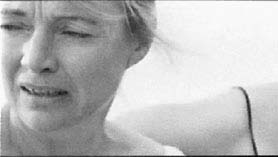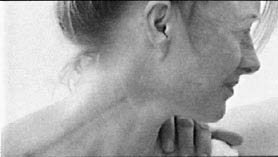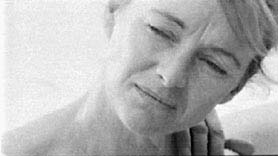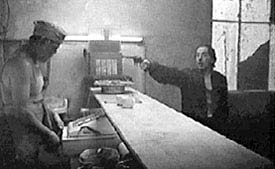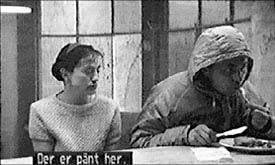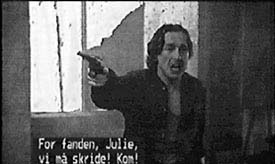P:O.V. No.3 - On
two or all three of the short films
Edvin Kau
- Conventions and questions
- The Beach, narrative structure and dialogue
- Cuts and moves in space: Time
- Eating Out, narrative string and dialogue
- Actions and delays in time: Space
- Endings that do not fade away
The Beach and Eating Out both tell straight-forward
stories-about events that are planned or at least expected to develop according
to well known conventions-but in both cases go drastically wrong. In Eating
Out two young people try to rob a small burger bar, but fail to do so
because the girl prefers to get something to eat before they take the money and
run. In The Beach, two families' perfect, happy day on the beach is
turned inside out, when it is disclosed that one of the men is beating his
wife. We are faced with two unhappy endings that on the other hand turn
out to have at least some flavour of happy endings.
What is it that makes these stories more interesting than the simple strings of
actions and the dialogues we meet at first glance? How is it made possible to
relate something to an audience and at the same time produce an experience of
the dynamic shifting between three positions or levels: 1) Conventional or at
least well known situations with built in unproblematic outcome, which 2) is
broken down, only 3) to be replaced by unexpected, if also problematic, final
states? Or in other words, how is it that something or other in these
films gives the seemingly straight-forward narratives a twist, which pulls us
out of the almost trivial qualities of the situations, and at the same time
prepares for a final presentation that simultaneously with the reversal of
convention and happy outcome according to plans-still leaves room for
suggestions of hope and (some degree) of happiness? I shall try to point out
some elements that-as part of a rhetoric of the moving image-give these short
films some special qualities, which enable the filmmakers to accomplish this
feat.
The structure of The Beach may be described in this way:
- A pan from left to right followed by a tracking shot to the right gives an
overview of the setting and the first presentation of the situation. In this
way the film gradually closes in on what is going to be it's centre of
interest. The pan is very slow, and the shift from this first shot to the
tracking is also a remarkably slow dissolve. Compared to these first seconds,
the pace in the tracking shot is slightly faster. In this way the film leads
it's audience into the realistically stylized situation on the beach (the
visuals being combined with a gradual foregrounding of voices and sounds from
the people on the beach).
- Persons and activities on the beach: a) Anne's husband playing cricket with
their son Simon and the other two boys. b) Her friend Margie's husband Jeff by
the water with two small girls.
- Presentation of the two women lying under their parasol on the beach.
Lazily Anne and Margie exchange a few lines of dialogue (small talk about what
the others are doing, and how hot it is, while they sit up).
- The disclosure of David's violent behaviour. Anne finally confides in
Margie.
- Margie orders David never to hit Anne again. And punishes him by kicking him
in the groin.
- Margie tries to divert Simon from the dramatic conflict. Playing in the
water with him she seems to succeed. But a few moments later he is again
absorbed in what has been going on, looking back at his mother.
- Anne's and Simon's eyes meet across the space of the beach.
This structure is so concentrated that it only just manages to resemble a
narrative. With a visual space that is cut to the bone and a sparse dialogue
that holds only what is essential, you might regard it as one concentrated
statement, almost one burst, which at the same time is both presentation of
characters, problem, solution, and conclusion. But where does the film differ
from any other well-meaning contribution to debates about battered women and
attempts to find measures against violent husbands? We will get back to this.
First a few words about the dialogue.
Before and after Anne's and Margie's talk, the lines are few, and they closely
follow the action. First David makes a few remarks to the boys about their
playing cricket. And afterwards, Margie and David exchange angry words, which
are strongly and exclusively connected to their physical attitudes and actions
and to the shots designed to show just that. The most important part of the
dialogue is, of course, Anne telling Margie about David's violent behaviour.
After a remark about the temperature and a gentle stroke down Anne's sweating
back, Margie sees the big bruise: "How did you do that?" Followed by this
dialogue:
|
A:
M:
A:
M:
A:
M:
A:
M:
A:
M:
A:
M:
A:
M:
A:
M:
A:
M:
A:
M:
A:
M:
A:
M:
|
"What?"
"That."
"Oh-I slipped on the back steps."
"Oh.-Mmmhhh (she sighs in the heat).-How come?"
"How come what?"
"That you fell down the steps."
"Oh-ah. I don't know, I-I just did."
"You okay?"
"Yeah."
"Anne, what happened?"
"Look ..."
"Yeah?"
"Ahh-forget it."
"Anne, what's going on?"
"Nothing."
"Anne, I'm your friend! I can see it's not nothing. Why are you souptight?"
"If you must know, David kicked me."
"What?"
"I said, David kicked me!"
"I heard you, but why?"
"David hits me."
"What do you mean he hits you?"
"I mean just what I said-he hits me."
"(What the) Fuck do you mean he hits you?"-How long has this been going on?"
|
|
(David comes from the cricket game, and Margie attacks him). |
Just like the over all structure of the beach episode, this dialogue is not
much more than a demonstration of the problem, as it is discussed in public
debates or presented in television news, for instance, whenever someone is
trying to influence politicians, social authorities, or public opinion in
general.
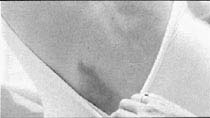
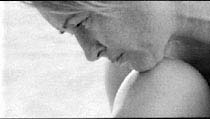
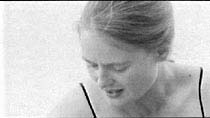
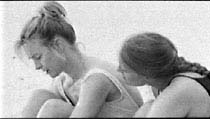
Fig. 1-4.
But where is the difference, then? Because there is a difference, I
think. How is this brought about at all? The most important part of the
story is told neither through the outlined narrative structure, nor through
information presented in the dialogue. The emotional complexity of what Anne
(and her family) is going through-and its possible impact on the audience-is
brought to the screen through the manner in which a certain part of the two
women's talk is visualized. And the crucial part is not just their conversation
as a whole-but is in fact narrowed down to a delimited part of it. And
especially concentrated around-not in!-some of their lines, Anne's in
particular. The important shots are of Anne's doubts whether to tell Margie
about David or not, and the fact that she decides to confide in her friend. The
most interesting part of the story results from certain practices of a
cinematic rhetoric.
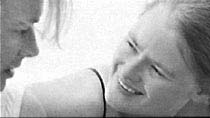
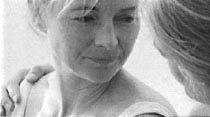
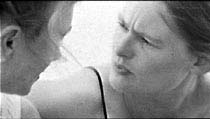

Fig. 5-8.
From Margie's discovery of the bruise on Anne's back, 12 shots deserve analysis
in some detail. Three close-ups of the bruise (Fig. 1), Anne (Fig. 2), and
Margie (Fig. 3) bring us to a two shot (Fig. 4) that is held without any cuts
through several lines of dialogue, until Margie says that she "can see it's not
nothing". From then on and until the end of their talk (Fig. 12), everything is
shown in close-ups, while Anne is telling about the problem. But the first 5
shots and the cut between Fig. 4 and 5 are just a prologue to what I consider
the most interesting meaning producing practice and the core of this film: What
is told without words and "outside" any logic of just a string of events. The
cut that brings also Anne in close-up again (Fig. 5-6) and the little
pause before she says "If you must know..." in Fig. 6, are just another pair of
steps in that direction.
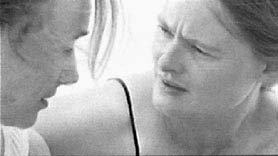

Fig. 9 a-b
|
The crux of the matter is that the spatial articulation brought about by the
cutting practice I have described makes the pauses, especially in Anne's
account, speak about her hesitation, insecurity, fear, despair, and doubts.
About her psychological state. She speaks the line "I mean just what I said-he
hits me" in the course of two shots (fig. 8-9). And her hesitation is literally
given space by the cut. The pause starts before the cut, and the tension of her
hesitation is built up by the fact that the spatial dynamic of cut plus change
of angle is not followed by any aural dynamic-since the pause lasts some
time into the next shot. Furthermore, it almost looks as if these moments are
expanded by Anne's movements. She turns her head to and from Margie (Fig.
9a-9b), and together with the combination of pauses and cuts these movements
constitute a spatial articulation of the situation, and in fact give physical
quality to time and psyche.
As soon as you become aware of this intricate solidarity between spatial
articulation and the way we experience time as meaning, other examples are at
hand. In this context, movement (and silence; Fig. 10 b-c) and cutting as a way
of expressing Anne's state of mind, are foregrounded in a cut on movement,
which almost has the quality of a jump cut (Fig. 9b -10a). Subsequently, not a
word is spoken during the last two shots in this series (Fig. 11-12). What this
passage gradually narrows in on, and what I have emphasized, it becomes
possible to embody in shots without a single word: not just the violence and
the necessity of getting the problem out in the open, but Anne's insecurity and
hesitation to admit the family's problems to the surroundings. This is told
through pauses and in ways I have exemplified. Silence and time articulated in
movements and the editing of space.
 
Fig. 11-12
|
During Anne's and Margie's conversation (and specifically the way it is
visually articulated in space), movements within the shots, especially Anne's,
and the montage of the shots, tell another story besides or beyond the facts of
dialogue and narrative. In other words, these examples show that a film story
is more than a string of events or a number of lines of dialogue.
Eating Out is just as minimalistic as The Beach. Its narrative
can be summarized as follows:
- A normal day in a burger bar. The owner is preparing a burger for a
customer, who eventually starts eating it.
- The robbery 1. Moments after a moped is heard arriving off screen, a young
couple (Roy and Julie) enter. Roy waves his gun and starts shouting that he
wants money from the owner.
- The robbery 2. The course of events in this standard robbery pattern is
delayed and in fact stopped, mainly because Julie is hungry! She wants a burger
like the one the first customer is eating. The owner says that he can't do two
things at the same time and asks if Roy wants the food or the money first. The
result is that Julie has her way.
- When a police car's siren is heard, Roy can't control himself anymore. He
panics and runs from the place, whereas Julie stays and eats her burger
Again we have a well defined situation or narrative string-which is turned
upside down and rebuilt into another/a new and unexpected structure. As in
The Beach we meet a narrative which at first glance seems well known and
therefore unproblematic to the audience. This time it is a robbery, an almost
standard ingredient in countless genre films.
From crime, gangster, and detective films we know the situation and what the
characters are supposed to be like. James Cagney-types and wild bunches do what
they have to do. Bonnie & Clyde do it their way, and Mickey & Mallory
of Natural Born Killers have learned their lesson from Oliver Stone. We
all know what is going to happen, when the young couples of the movies enter
the bank, the gas station, the drug store... They go in, take the money, and
run. Simple as that. Of course, there may be unforeseen or accidental
obstacles, and they may be designed by the storytellers to provide some keys to
the solution of the crime later on in the movie. But with or without
difficulties, an initial robbery like this is generally carried through with
some degree of success. Only then, the trouble is allowed to begin.
But, as we have seen, Eating Out has a very special variation to this
formula. And as in The Beach, the question is: What is breaking up the
prototypical course of events? How does this film manage to tell a different
story; apart from the fact that a girl named Julie gets hungry at this
unfortunate moment. She (and Roy) is thrown off the track by the very place
they are in. (Had it been a bank or a bookshop, this would never have
happened!) She utters her wish-they disagree-but she has her way. The
consequence-within the dynamic of the narration as story-telling activity
(e.g., the way the film chooses to articulate this as a rhetorical
construction of specific meaning; and not in some series of causes and
effects)-is that time becomes an even more essential factor than in
ordinary robbery scenes (Fig. 13-15).
Time is drawn out like a rubberband. Things that are supposed to happen in this
kind of scene are delayed and finally given up, as Roy runs from the bar. He is
doing what they are used to in a situation like this, but contrary to that
Julie chooses to stay. In fact, she finds a new refuge, and a new kind of
security and friendship.
This is due to what? Precisely to the fact that the timing of their decision is
so radically out of sync with normal dynamics and developments over time in
this kind of situation. Then, of course, everything goes wrong. Time is
articulated and embedded in their actions in a way that , finally, changes the
room. From the scene of a crime (to flee from), it becomes a place to stay.
This gives new importance to the spatial articulation and sensuality of the
surroundings.
Eating Out handles time as a material in a way that emphasizes spatial
qualities. The more time becomes an issue, the more importance is given
to the question of staying in place or leaving. To Roy, the place
becomes almost claustrophobic, he has to run. As robbers, they both should. To
rob people and to run is a question of time, and this makes places and delays
not only important, but potentially dangerous! Julie stays, and in staying with
her the film stresses the "space part" of the time-and-space-dynamics of the
moving images. This may also be one of the explanations for the emphasis that
is given to the sensuality of the pictures. The place is very important, and
regardless of how dirty it may look, this ultimately is part of its homeliness
(Fig. 16).
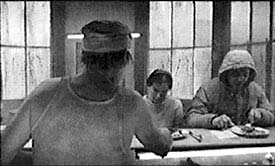
Fig. 16
|
In this way the formal characteristics of time and space, and the way they are
articulated in shaping the story, become elements in building thematic
structures: Julie says: "It's nice here! (...) We don't ever meet anybody! We
never stay anywhere more than a few minutes-and don't get to know anybody!" To
stay in a certain place, to choose and to belong is important. And: What will
happen to Julie and her customer friend-and the burger bar owner? For now,
maybe for the first time in her life, Julie feels secure and close to another
human being. It's cold, and the other customer at the bar says: "You may lean
on my parka coat, if you want to" (Fig. 17).

Fig. 17
|
The fictional, stylized world of Eating Out is articulated in time in a
manner that leaves us with an ending dominated by the spatial articulation of
the room, its sensual qualities and the people feeling at home there. The
time-element is so to speak sucked out of the conventional model of cinema
robberies.
In both films well known patterns are turned upside down. The robbery fails,
and the nice day on the beach takes an unhappy turn. But, as I have described,
this is turned around once more: 1. Julie finds a new friend and a refuge in
the "homely" burger bar. 2. As the problem of David's violence is disclosed,
Anne and her son Simon reach a positive understanding and new strength,
mirrored in Simon's expression and just a shadow of a smile.
Above I asked how these films manage to produce meaning that makes it possible
to find new kinds of more complex (or even ironic) happy endings; meanings that
go beyond narrative structure and dialogue. The answer lies in a cinematic
rhetoric which is a result of aesthetic practices In this case an articulation
of space that gives weight to the experience of time and emotion (The
Beach) and an articulation of time that results in a strong sense of space
and place (Eating Out). So, these specific practices-as ways of handling
a seemingly aesthetic "surface"-trigger meanings. This makes it possible to
present levels of meaning that tell stories which go beyond mere series of
actions and words.
It is an interesting element in both films' narrative patterns that they do
not end in a fade out after presenting some consequences from a
prototypical string of events (even if it's altered, as I have described
it)-but make use of their final stages to present quite new or redefined states
of affairs. The endings are not just open in the usual sense of the word. They
are new centres of the stories. They may even promise new developments, and at
any rate they encourage new steps in the interplay with the audience; not just
in reflecting back into the stories of the films so to speak, but in
considering possible new situations or developments from the points where the
films leave the characters. In this way the moving images demand-and
educate-active audiences as co-operators in the construction of this kind of
narrative.














